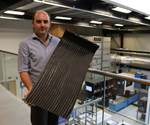General Atomics completes SiC SiGA-cladded fuel rod testing
Irradiation testing experiment validates composite cladding robustness and integrity after exposure to high neutron flux, indicates promise for use in future nuclear power systems.
General Atomics Electromagnetic Systems (GA-EMS, San Diego, Calif., U.S.) recently completed its first round of testing at Idaho National Laboratory (INL, Idaho Falls, U.S.) on unfueled nuclear fuel rod samples using the company’s SiGA high-temperature fuel cladding material.
SiGA is a silicon carbide (SiC) composite material that forms the basis for the development of nuclear reactor fuel rods that can survive temperatures far beyond that of current materials. This initial experiment is part of a series of tests with the U.S. Department of Energy (DOE) to commercialize the fuel cladding early next decade.
According to GA-EMS, the SiGA-clad fuel rods successfully survived a 120-day irradiation testing period in INL’s Advanced Test Reactor (ATR). Testing was conducted to validate the robustness and integrity of the SiGA cladding after exposure to high neutron flux in a pressurized water reactor environment. Following the test, SiGA-cladded rods remained intact and showed no significant mass change, indicating promising performance. More detailed examinations are underway to further evaluate post-test data to validate individual rod integrity to remain gas-tight, with no evidence of degradation, leaking or structural change.
“The testing results offer critical, quantifiable and independent validation that our SiC cladding technology is on the right path to provide a safe, suitable, accident-tolerant fuel cladding solution for the nuclear fleet,” says Scott Forney, president of GA-EMS. “This success is a key milestone on SiGA cladding’s development path to enhance the safety of the existing U.S. fleet of light water reactors, particularly during an unlikely event of an accident. It could also do the same for the future generation of advanced nuclear power systems.”
SiGA’s multi-layered SiC composite cladding structure is sealed with a fully SiC joining process, enabling high stability during operational temperature cycling. According to the company, this material provides greater stability and safety at temperatures up to 1900°C, well beyond that of metal fuel rod claddings. SiGA cladding would also enable higher powers and longer fuel lifetimes, thereby enhancing overall reactor performance and economics. GA-EMS has been under contract with the DOE to support the Accident Tolerant Fuel Program and advance GA-EMS’ technology for future deployment in U.S. nuclear reactors.
“We look forward to continuing our partnership with the DOE and the national labs to accelerate the irradiation testing to demonstrate the performance of fueled SiGA-cladded rods. The planned test series progressively builds up performance data to show that SiGA cladding can effectively contain the fuel and any gases that are produced when subjected to irradiation and high temperature,” adds Dr. Christina Back, vice president of GA-EMS Nuclear Technologies and Materials. “In parallel, we are scaling up to full-size, 12-foot-long SiGA rods and will then be doing the irradiation testing in actual commercial reactors with deployment targeted for the mid-2030 timeframe.”
Related Content
-
Infinite Composites: Type V tanks for space, hydrogen, automotive and more
After a decade of proving its linerless, weight-saving composite tanks with NASA and more than 30 aerospace companies, this CryoSphere pioneer is scaling for growth in commercial space and sustainable transportation on Earth.
-
Dawn Aerospace reusable rocket-powered aircraft flies twice in one day
Eighth and ninth flights of composites-intensive Mk-II Aurora reach an altitude of 63,000 feet, demonstrates same-day reusability capability for rocket-powered systems.
-
TU Munich develops cuboidal conformable tanks using carbon fiber composites for increased hydrogen storage
Flat tank enabling standard platform for BEV and FCEV uses thermoplastic and thermoset composites, overwrapped skeleton design in pursuit of 25% more H2 storage.

















